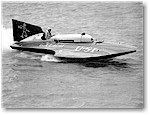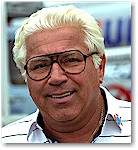
The World According To Lee
 |
| Gale, formerly the third Notre Dame and Miss Frostie was the first boat Lee Schoenith drove. It was later the first Miss Wayne and still later, Miss Ricochet. |
When Lee Schoenith was a boisterous 21-year-old, his dad bought a Gold Cup boat for him to drive. It was 1950, and colorful Detroit bakery magnate Jack Schafer, owner of the Such Crust boats, had talked Joe Schoenith into buying an old 1940's step hydroplane which had been one of Herb Mendelson's Notre Dames. Schafer told Joe that it would be a great way to publicize his W.D. Gale electrical contracting business.
That boat became the first in a line of sixteen Gale race boats owned by Joe Schoenith. As Lee recalled some years later, she was a strange and wonderful craft.
"Naturally, we wanted to change her," he began. "It took us about a year to get her running the way we wanted. Looking back, I've got to admit we had sort of a Mickey Mouse set-up. And the cockpit was directly over the transom and prop giving a miserable ride.
"We had a riding mechanic in those days. The toughest job we had was getting someone to ride along. Everybody went once, nobody went twice. I remember the President's Cup of 1950. I drove and somebody rode the first heat. Came the second heat and I couldn't find him. So I grabbed Bill Muncey for the second heat. Came the third heat and I couldn't find him either!
"I talked Gary Hooker into riding the third heat and before we were a thousand feet from the dock he was hollering 'Take me back, take me back!' I couldn't blame him. It was a rough ride with no way for the mechanic to hold on. The driver at least got to hold the steering wheel; the rider got nothing but bruises."
For rookie Lee Schoenith, such was the state of big boat racing in the early '50's. It was ragtime, seat of the pants boat racing. But, over the next 40 years, the name of J. Lee Schoenith would stand at the forefront of positive change and lead the professional status that Unlimited racing enjoys today.
From 1950 until his untimely death in 1993, Lee was Unlimited racing's mover and shaker. In his role as a driver, he was national champion for three straight years and, in 1955, he won the APBA Gold Cup; his crowning achievement. He served as Unlimited Commissioner for eight fruitful years beginning in 1962, his brash, non-nonsense style earning him the moniker "CZAR". In fact, it was Lee who conceived and ramrodded the concept of detaching the Unlimiteds from the APBA rules structure and striking out as a separate category in 1958.
With the exception of two seasons where they dominated, winning seldom came easy for the Schoeniths, but shear longevity produced hundreds of trophies, including 27 race victories and scores of place, show and qualifying awards.
 |
| Gale II. Lee Schoenith and Danny foster drove this boat to victory in 1952 and 1953. |
 |
| The Gale team of Bill Cantrell (left), Joe Schoenith (center) and Lee Schoenith. |
 |
| Lee ready to go in the Gale II |
Lee's first win as a driver came in 1951 while he was home on furlough from the Army He took the William Randolph Hearst Trophy at Washington, D.C. driving Gale II. He was in Korea in 1952, so Joe hired Danny Foster to drive that year. Foster won the Silver Cup at Detroit in the second Gale. Lee was a civilian again in 1953, winning his own Silver Cup and becoming driver champion at season's end.
Joe Schoenith built two new boats for 1954 and hired the great Bill Cantrell to join Lee as his drivers. Together, Lee and Wild Bill won every major race but the Gold Cup. Lee and Gale V took the national high point championship. Cantrell and Gale IV were second.
1955 saw the Gale camp finally win the coveted Gold Cup at Seattle, and again Lee totalled more season points than any other driver. Winning back then, though, had its price. "That was the year we bent or broke between 10 and 12 props," Lee remembered in a 1964 interview. "Oh, that was an expensive year."
With the Gold Cup back in Detroit for 1956, the Schoeniths fielded a three boat defending team which failed against the onslaught of top-notch boats from the west coast. Lee drove the twin-Allison powered Gale Vl, which porpoised so badly down the straightaway that it was uncontrollable. Bill Cantrell drove the new, but erratic Gale V, and Roy Duby handled Gale IV, the oldest and best of the lot.
Lee retired as a driver in 1958 after aggravating an old back injury when the Gale VI flipped and sank while leading a race at Elizabeth City, NC. It was around this time that Lee emerged as a voice for change in the sport. He saw the need for professionalism, prize money and rules that were geared toward the largest and fastest race boats in the world.
In Lee's own words, he described the situation as he saw it: "The Unlimiteds were governed by APBA officials who believed Unlimiteds could be operated by Limited inboard concepts. The theory was excellent, the practice impossible. As a driver I had experienced how impossible.
"Voting was cumbersome. Regattas were haphazard. We needed some new rules and standardized course and racing conditions. I argued. I fought. I yelled. I admit it. But we got our new Unlimited Racing Commission.
"We got rid of steel buoys, for instance. Steel! Can you imagine hitting one of those things at 150 mph? We got camera-photographed starts to confirm gun-jumpers and protect legal starters. We even got a rule in that says you can't fight in the pits. I realize that takes a lot of fun out of it all, but it's a good rule."
Change is often difficult. Lee made enemies, especially on the point of bringing commercial camps into the sport and making it professional. Yet, every change he introduced had a positive outcome. In the years that followed (through the sixties and into the seventies) Unlimited hydroplane racing received higher public interest, the purses were greater, the races more numerous and the number of new teams with high quality equipment increased.
As an owner, Lee followed his father's lead and kept the Gale racing team top campaigners on the circuit for 25 years. While other teams came and went, the Gales were always there
The year 1958 also saw the opening of the fabulous Roostertail Night Club and restaurant, another Schoenith business venture built on the banks of the Detroit River overlooking the race course. The Roostertail would become a mecca in the midwest for top name talent and racing fans for the next decade.
An Internal Revenue ruling in the early sixties disallowed the Schoenith's pleas for write-off status on their racing endeavors. According to the IRS, just because the boats' names were Gale, it didn't have a direct relationship to the W.D. Gale Electric Company that they were purportedly advertising. As a result, Joe and Lee could no longer afford boat racing.
They were ready to pack it all in in 1963 when Lee met Ralph Hart of the Heublein Corporation. "Around 1963, a large liquor corporation (Heublein) bought out Arrow Liquor here in Detroit," Lee recalled in a 1979 interview. "Heublein's head man, Ralph Hart, was looking for something interesting to advertise Smirnoff Vodka. We got together and Ralph sponsored our boats for five years."
In 1964, driving Lee's new Miss Smirnoff, Bill Cantrell won the President's Cup and had one of the fastest boats on the circuit by season's end. Boat racing helped Heubleins sell a lot of vodka in the next four years, but three different Smirnoff hulls didn't win any more races. In 1968, the firm dissolved its sponsorship pact with the Schoenith's.
The deal in 1971 that brought the Schoeniths, Atlas Van Lines and the great Bill Muncey together was magic. Lee and Bill, who had been arch-rivals as drivers in the fifties, were now on the same team. Along with now-team manger Bill Cantrell and Atlas chairman O.H. Frisbie, the Gale camp was nearly unbeatable, taking six of seven races in 1972 and winning the national championship.
Those were the days. The Schoenith team was back on top after 17 years of struggling with marginally competitive boats, loss of sponsorships, the IRS, and Lee's hard-nosed attitude.
 |
| Lee Schoenith in the early '90's. Photo courtesy Stephen Lane. |
What followed after that banner year were three winless seasons, and Joe decided to hang it up. He and his wife Millie retired to Florida, where they still reside. Lee stayed with the Unlimiteds as an official, serving as chief referee, deputy commissioner, and as an advisor to the Spirit of Detroit Thunderfest board. In November of 1993, Lee passed away after a long illness.
The Unlimited Racing Commission annually bestows the Lee Schoenith Award on a person or persons making long-term contributions to the sport. Lee himself would present the award at the annual URC awards banquet. The last J. Lee Schoenith bust awarded while Lee was still alive went to boat owner Fran Muncey in 1993. This year, following his death, Lee's wife Shirley and sons Joe and Jay presented the award to former driving champion and Gold Cup winner Tom D'Eath.
Although he put up a brash, "hard as nails" front when lobbying for rules changes or meting out an unpopular decision when he was referee, Lee always had a deep love for his family and his fellow racers. His lust for the good life was equalled by his sense of humor. On one occasion, while basking in the championship glory of their 1972 season, Bill Muncey noted: "I asked Lee if he would still love me if I started losing? "Sure I'll still love you," Lee answered, "But I'll miss you."
And we'll all miss you, Lee.
(Reprinted from the 1994 APBA Gold cup program)
Hydroplane
History Home Page
This
page was last revised Thursday, April 01, 2010
.
Your comments and suggestions are appreciated. Email us at wildturnip@gmail.com
© Leslie Field, 2001